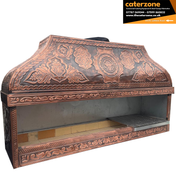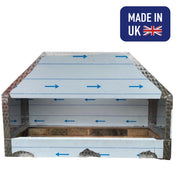Effective Storage Solutions for Catering Kitchens
Effective storage solutions enable catering businesses to maintain organized kitchens and well-maintained equipment.
Smart storage solutions are essential for professional kitchens to operate efficiently. This helps keep the kitchen running smoothly. Businesses must ensure proper management of their space and equipment for best results.
Caterzone understands the challenging issues restaurants and catering businesses face when organizing their kitchen spaces. Choosing the appropriate storage solutions can substantially impact kitchen performance. Proper storage enables kitchens to function more efficiently and maintain equipment condition.
The process of organising equipment involves more than simply locating storage areas for items. Effective kitchen organization involves detailed planning and understanding equipment movement to implement intelligent storage solutions. This makes the kitchen run better.
An effective kitchen management system requires a structured approach to equipment storage. The storage system protects costly kitchen equipment and maintains cleanliness while speeding up food preparation. Efficient kitchen operation requires proper storage solutions.
This guide teaches you the best methods to organize and store your catering equipment. This guide provides valuable advice to enhance your kitchen functionality.
Essential Principles of Commercial Kitchen Organisation
Commercial kitchens must maintain effective organisation to achieve improved operations and efficiency. Restaurants and catering companies must devise effective strategies to manage their space and stock resources.
A successful inventory management system requires thorough knowledge of storage methods. Kitchens require structured organizational practices to operate efficiently every day.
Establishing Dedicated Storage Zones
The establishment of designated storage areas enhances kitchen operations while simultaneously reducing preparation time. Important areas for organisation include:
- Dry goods storage
- Refrigerated sections
- Cleaning supply areas
- Equipment storage spaces
Implementing FIFO Storage Systems
The First-In-First-Out (FIFO) method plays a crucial role in the management of fresh ingredients. It helps:
- Reduce food waste
- Keep ingredient quality consistent
- Improve stock rotation
- Boost food safety
Temperature and Humidity Control Guidelines
Maintaining the right environmental conditions ensures that both ingredients and equipment remain in optimal condition. Caterzone recommends monitoring storage conditions carefully to prevent spoilage and damage.
The best kitchens should prioritize acquiring reliable temperature and humidity control systems. By protecting their resources they can maintain high quality standards.
Effective organization and storage methods for catering equipment help kitchens maintain a smooth operation.
Efficient organisation of catering equipment enables kitchens to maintain smooth operations. Proper organization leads to efficient use of space and faster kitchen operations. Professional kitchens require intelligent management systems for their equipment to optimize accessibility and operational performance.
Start saving space with smart storage ideas. Kitchen managers and chefs have multiple techniques available to improve their storage solutions.
- Organize your equipment based on how frequently you use different items.
- Use vertical storage solutions
- Make sure everything is clearly labelled
- Maximize your kitchen space by utilizing every available area.
Vertical storage is great for small kitchens. Magnetic knife strips and overhead shelves paired with wall-mounted racks help maintain an orderly kitchen space. They keep important tools within reach. Professional kitchens can find numerous storage solutions through Caterzone.
Maintaining your equipment properly remains essential. Regular cleaning and inspection of tools prevents them from deteriorating. Develop a routine for cleaning equipment while oiling moving parts and performing routine checks.
Applying these storage strategies results in more effective kitchen operations. It reduces mess and boosts productivity.
Conclusion
Keeping a professional kitchen tidy is key. Smart storage solutions enable chefs to function more effectively while extending the life of their kitchen equipment.
Good maintenance of kitchen tools is essential. Regular storage inspection and organized maintenance helps prevent equipment damage. This keeps your gear in top shape.
Caterzone suggests checking your storage plans often. A kitchen that operates smoothly and produces less waste results from having a proper organization system. It also makes food safer.
Multiple resources exist to help you learn about proper storage and maintenance of kitchen equipment. Keeping your methods up-to-date through learning enhances organization and efficiency in your kitchen.
FAQ
What are the most important considerations when storing catering equipment?
Key points include setting up specific storage areas and using a First-In-First-Out (FIFO) system. It's also vital to control temperature and humidity. Organise equipment by function and how often it's used.
Caterzone advises using vertical storage and labelling items systematically. This helps keep your equipment safe and efficient.
How can I maximise storage space in my commercial kitchen?
To save space, use vertical storage and multi-functional shelving. Stackable containers and clever organisation are also helpful. Consider wall-mounted racks and under-counter storage.
Caterzone has a variety of space-saving solutions for commercial kitchens.
What is the best way to maintain catering equipment during storage?
Regular cleaning and drying equipment before storage are essential. Use protective covers and store in a clean, dry place. Keep temperature and humidity controlled.
Check equipment regularly and store it away from heat, moisture, and sunlight.
How often should I clean and organise my catering equipment storage area?
Clean and organise your storage area weekly. Do daily quick checks and clean immediately after use. A weekly deep clean and reorganisation is also necessary.
This keeps your storage area clean and hygienic.
What are the best practices for storing different types of catering equipment?
Store metal equipment in dry areas to prevent rust. Electrical items need protection from moisture and dust. Delicate items should be in padded cases.
Heavy equipment goes on lower shelves to avoid accidents. Caterzone offers specific storage solutions for each type of equipment.
How can I prevent damage to catering equipment during storage?
To avoid damage, use protective covers and avoid overcrowding. Use proper shelving and keep equipment clean and dry. Separate delicate items from heavy ones.
Use padding for fragile items. Regular maintenance and careful handling are essential.
What temperature and humidity conditions are best for storing catering equipment?
Store equipment in temperatures between 10-21°C (50-70°F). Humidity should be 45-55%. Avoid extreme temperature changes.
Use dehumidifiers or climate control if needed. Caterzone recommends monitoring equipment storage conditions.



